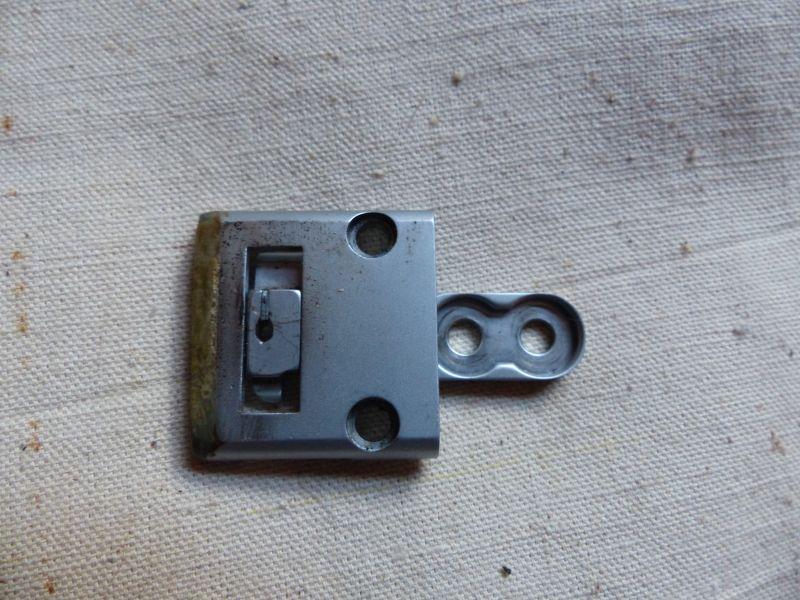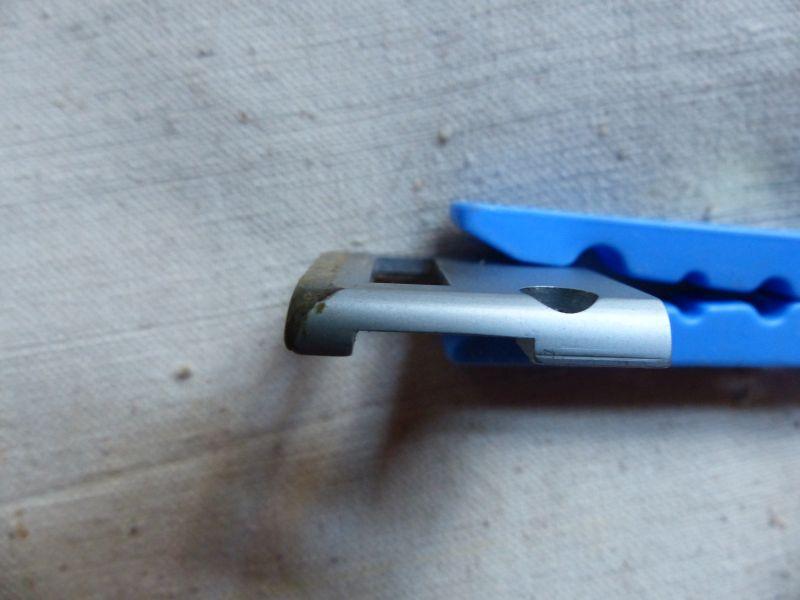-
Posts
4,784 -
Joined
-
Last visited
Content Type
Profiles
Forums
Events
Blogs
Gallery
Everything posted by dikman
-
A light automotive grease, or lithium grease, or moly-disulphide grease - it's not going to be too critical, especially if you're going to run it fairly slow with a servo motor. For $100 I would have taken both!!
-
Who'd have thought of making donut-shaped magnets? Or even looking for them? I found another use for my press. I have two Macadamia trees and the nuts are so hard that I have to crack them using an engineer's vise. Makes for a slow job. Guess what, the press does a pretty good job of cracking them too (and it's a bit quicker).
-
I don't know about prices over there but when I was looking at getting a 4500 I thought about a 3200 as it seemed like a nice size machine but there was a minimal price difference here so it made sense to get the bigger machine. Now that RockyAussie has developed the narrow needle plate and feed dog to use #138 on thinner material it makes the 4500 much more versatile and probably better value.
-
When I first thought about it I wasn't sure it would work either, but the fact Sam Andrews uses one proves that it does, in fact, work. The only proviso could be in the grade of aluminium used, some are harder/denser than others. kgg, I needed mine to fit on the left side of the grinder, which is a left-hand thread, plus the shaft is too short to extend past the burnisher. Finding such taps here isn't easy and the lathe I had back then couldn't cut threads. Your ideas should work.
-
Spyros, the same thought occurred to me once, but as you say I don't think it would stand up to the pressure and speed. kgg, I thought about making one out of aluminium as it would be pretty easy to do on the lathe but the biggest problem was how to cut the thread for the shaft in the ally. The advantage of wood is that I could drill the centre hole slightly undersize and then force it onto the shaft, using the shaft thread to cut a matching thread in the wood.
-
Not much missing from that list, Spyros. I reckon, though, once you get that narrow plate fitted and sorted you're not likely to use much of the other bits, other than maybe a couple of the different feet. I've never bothered fitting the belt guards as I always find them a nuisance. Exciting times ahead.
-
Now where would the fun be in that? What bits did you end up getting with it? I assume you're getting the complete setup with the table?
-
This is the guy, you can see his burnisher at 13m 29secs. He has other videos too.
-
Spent all morning sorting out my machine, it was a combination of things. Now, I haven't used this machine for a while and had threaded the takeup spring wrong (although it still worked as 95% of the stitches were fine). I also checked the needle timing and while it was obviously fine with thicker thread I could see a potential issue with thinner stuff so dropped the needle bar just over 1/2 mm. I re-balanced the bobbin/upper thread tensions, plus I had also forgot to back off the foot pressure for lighter material. After doing all that I could sew two layers of suede with no problems, doubled it up and still good. NOW it's doing what I hoped it would, so for around $140 (plate/feed dog and needles) I've effectively got another machine, in between an upholstery-class and harness stitcher. Impressive. And I'm not posting a picture of the quiver, while it's functional it didn't quite turn out as I envisaged (not pretty!).
-
Brian, I adjusted mine according to Uwe's excellent video so I'm pretty sure my settings are correct. I'm not panicking (yet) as I'll do a bit more experimenting when I've finished this quiver. Yes, new plate set and needle. It occurred to me last night to check the thread path, as whatever the problem is it's relatively minor, and yes, it could be the suede getting pushed down the hole slightly. I'll try a few different materials and see if there's a pattern, I'll find it.
-
Yep, Sam Andrews uses aluminium so it can't be too bad. I made a couple out of wood, one using a hardish wood the other a slightly softer wood and both work fine, but I think hardwood would be better than softwood.
-
You won't regret it (well, you might every time you think of the money!) but it will last you a lifetime, which is more than you can say for a lot of things these days. I thought I'd better try out this new plate, I need to make a quiver so after lots of thinking (makes my brains hurt ) I came up with a design, of sorts, using canvas and suede. I figured it would be a good test for the #138, and it won't matter if I stuff up the stitching a bit in the process as it's going to be a knock-about thing anyway. I'll post a photo when it's finished. Unfortunately I've had a few missed stitches and I'm wondering if the hook timing isn't quite accurate enough for the thinner thread (or the thread tension isn't quite right).
-
Industrial strength - unlikely. Heavy duty upholstery and leather- unlikely. Walking foot - no. Dubious advertising, if not downright misleading, to say the least. As for not finding any reviews etc, that says it all.
-
I have an intense dislike of FB groups as I find them unstructured and it's difficult to find information without constantly asking the same questions for someone to answer - again. I've joined a couple but haven't been back for years. I much prefer forums, where you have various subsections to find specific information. Garyak, is your machine the same as the original photo in the thread? It just looks different. As for #207 thread, there's no way mine would handle that (and with the small bobbin I wouldn't want to try stitching anything very big), even #138 is pushing it. Mine is happy with #69. I must admit I haven't used mine since I bought it, I consider it for "emergencies" only. It was a challenge to get it running properly, which I enjoyed (as KGG said, it's a tinker's delight) but I have far better machines to sew with.
-

Transporting Industrial Sewing Machine
dikman replied to LePoisson's topic in Leather Sewing Machines
Glad you got it home ok. One reason for removing the head for transport is vibration, I'd rather it be laying down and padded. Pricewise I think you did good. -

Transporting Industrial Sewing Machine
dikman replied to LePoisson's topic in Leather Sewing Machines
I've moved a few, always remove the head unit (easy to do) and as Wiz said lay it down with plenty of packing (old blankets etc). I had to completely disassemble the tables to get them in my car, but again no big deal. Just take an assortment of tools - screwdrivers (Philips and flat blade), a socket set, adjustable wrench, pair of pliers and some rags to wipe your hands!! If it has a clutch motor be aware they are heavy, if possible flip the table on its back and remove the motor. Having a mini-van you might be able to get the table inside in one piece and so save a bit of work. -
You beat me to it, Chuck - that is a LOT of basket weave!! It does my head in thinking about it! A beautiful piece of work, Randy.
-
Nothing like a happy ending.
-
This is the plate and the feed dog that came with it. The left edge is rounded off and caused a problem with the foot that I had so I packed it out with epoxy to level it off. Incidentally, the metal that HK uses is HARD!!.
-
I've converted it back to a binder but I can post a photo of the needle plate later.
-
I bought the feed dog and needle plate from Kwok Hing and a generic set of feet from a local supplier to convert mine to a "standard" stitcher and it worked fine.
-

My Leatherwork shop tour video
dikman replied to Campleathergoods's topic in Leatherwork Conversation
Looks like a nice cosy setup. -
If you're referring to using it with a clutch motor then no, it won't work. A clutch motor is an induction motor and there is no known easy/cheap way to make them variable speed. Which is why servo motors were developed for sewing machines. That speed control works with what are often called universal motors, the types fitted to electric power tools (if the motor has brushes then it should work).
-
You're been a busy boy! Should be a good setup, the drum sander is a good idea. I just made a wooden burnisher and fitted it to a standard bench grinder (3400 rpm). How do you think the PLA burnisher will hold up? My experience has been that PLA doesn't take kindly to getting hot. It never occurred to me to fit a drum sanding thingy to a bench grinder, might be something to ponder on.
-
Norwegian, I can't help you with details on the machines, other than to tell you SV machines are extremely difficult to find information on. Manuals are virtually non-existent, except in rare cases. They are generally considered to be Special Versions/Special Variation (?) of a particular standard machine in that class. The trick is often figuring out which particular model they relate to. It is also often difficult to find out in what way they are different. The only way I can suggest is to try and identify any models in that class that look the same, try and find a parts manual and see if any of the parts appear to match what's already there. I did that once when I had one and identified an identical standard model, the parts numbers on mine were different but visually they all appeared to be the same in both machines. I never did figure out what made mine an SV model. One possibility, I suppose, is that the SV came first and then went into production as a standard model. Who knows?




